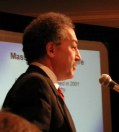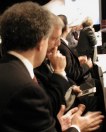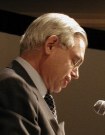danbricklin.com/log
|
|||
|
|
Starting January 6, 2002
Benhamou, Glauber, and Schmidt at the MSIC, Happy 18 Mac!, Not much new here -- busy at SATN.org, New Weblog from Bob Frankston and David Reed, Usability in the wild of suburbia, Two people I lost this week, More active mechanics, Happy New Year!
06-28Jan02
2002_01_06.htm
|
||
Monday, January 28, 2002
Benhamou, Glauber, and Schmidt at the MSIC
This morning was the Annual Membership Meeting for the Massachusetts Software and Internet Council, the one where we "officially" elect trustees, etc. As usual, the main order of business was personal networking and listening to speakers.
  Nice turn out as you can see from this view from the head table
The first speaker was Eric Benhamou, Chairman of 3Com, and interim CEO and chairman of Palm. I did his introduction which was based on the one on 3Com's web site. I added that when he was cofounder and VP of Engineering of Bridge Communications in the early 1980's, he actually came out to my company, Software Arts, to help get our Bridge Ethernet equipment installation running. With a masters in electrical engineering from Stanford, he has a real techie background.
   The view from my seat of Eric Benhamou speaking to us, and afterwards talking with Bob Frankston; showing the i705 to John Landry
His speech was titled "Painful lessons learned in 2001 by the IT industry". He talked about the fiber glut in the backbone, and the stalling of broadband last mile penetration, and how that slowed adoption of other things like home networks and Internet appliances. He felt that HomeRF was dead, Bluetooth OK (soon), and Wifi "thumbs up". "B2B = Back to Basics, B2C = Back to College." He added up the $150B "3G Spectrum Auction Orgy" in Europe, with an additional $150B needed to build out the totally new transmission infrastructure it requires. He sees specific-function devices as the future in a beyond-the-PC world. Then he talked about digital rights management, individual security and privacy, and cyberterrorism. He also briefly held up a new Palm i705.
The next speaker was Robert Glauber, CEO and president of the National Association of Securities Dealers. (The NASD says they are "...the securities industry's largest self-regulatory body, the regulator of the Nasdaq Stock Market, and the parent of the American Stock Exchange.") He served as Under Secretary of the Treasury for Finance from 1989 to 1992. Before that he was a professor at the Harvard Business School, where, among others, he taught me corporate finance. Listening to him speak was a deja vu: I could just hear him explaining those old cases that inspired me while I was developing VisiCalc. After it was over, he told the story how after seeing an early prototype of VisiCalc he was unenthusiastic. As I recall, that may have been the demo that was plagued by a balky disk drive cable.
  Robert Glauber speaking and afterwards
His speech dealt a lot with the problems of the IPO first day "pops" in the late 1990s. He explained why publicly held equity is better than debt because the markets react so quickly to news, keeping prices more appropriate. With IPO pops, money the companies could have received is left on the table in return for the "branding" advantage of the hype around the jump in stock price. "Eyeballs are eyeballs. Dollars are dollars," he said. He then went on to show how the value lost to companies could have made the difference to allow survival when the bubble burst. $30B was left on the table. "The difference between being Jeff Bezos and Jeff Bozo."
 Eric Schmidt speaking
The last speaker was Eric Schmidt, chairman and CEO of Google. As usual, he gave a thoughtful speech, from the techie view. Some snippets: They measure their data center by the electrical power it uses (a major expense) not just CPUs. 22 year olds getting out of college are all Linux programmers. Is Linux real? Yes -- it's an extraordinary technical success (ignoring the financial part for its original developers). It's already the technology of record for the next generation. He contrasted the wasted Super Bowl ads with word of mouth and direct selling. He talked about how Google is built (lots of PC-hardware machines connected to 1Gb Ethernet to 256Gbps routers). He talked about problems with innovation: Need small teams less than 10 people, sales wants to build what the customer wants which is usually basically the same as existing products, and there is a lack of technical focus at the top of companies. Data storage: Prices are such that you can be RAM-centric instead of disk-centric with a 200,000 speed improvement (that's what we got with VisiCalc doing the spreadsheet in RAM instead of executing data from disk in the old days, but he's talking about gigabytes of RAM). Performance vs. power consumption: The Pentium 4 is tiny, but the heat sink and fan needed to cool it are huge. Go back to first principles: Look deeply at the technical underpinning and assumptions to see how to innovate and get great improvements.
Friday, January 25, 2002
Happy 18 Mac!
To celebrate yesterday's 18th birthday of the Macintosh (as pointed out by Dave Winer), here's a link to the story behind the advertisement that launched it (I especially like the part about the difficulty in finding an actress who could twirl and throw a hammer well -- I never thought about that -- and that the board of directors hated it at first). The URLs of the script and other old material on the Chiat/Day web site don't work any more, but you can find it saved on www.archive.org
Monday, January 21, 2001
Not much new here -- busy at SATN.org
I haven't had much time to post anything new here on Bricklin.com. I was busy getting SATN.org off the ground. Bob, David, and/or I, have been posting something there every day or so. So, read SATN.org.
(I'll have some new stuff here later this week or so.)
Sunday, January 13, 2002
New Weblog from Bob Frankston and David Reed
I get a lot of email from my friends Bob Frankston and David Reed. We like to share comments on the techie world with each other, and CC each other on various emails to others. I've been trying to convince them both to keep a weblog in addition to their less frequently updated web sites, but they haven't gotten around to it. Finally, last week, David sent an email about ASCII vs. binary data that he CC'ed me on that I felt was worth posting. This time, rather than just put it here on my weblog, I bought them a domain name and set up Blogger for them. I used Trellix Web/CuteSITE Builder to create the static pages, and to post David's email as an essay. (I decided to use Blogger for them to post because it seemed a good tool for the task, and, because of Trellix's relationship with Evan and the product, I felt I ought to be using it for real anyway.) To speed things up, I used a slight variation on the theme I use here as the design of the web site.
Take a look. The new weblog is www.SATN.org. SATN was the designation we used at Software Arts in the early 1980s for our technical notes, and satn.org was available. (David suggested it after I gave up on "bobanddavid.com", etc.)
Both Bob and David are well-known computer pioneers. Bob co-created VisiCalc with me, and worked at both Lotus and Microsoft. David got his Ph.D. at MIT and was a professor of computer science and engineering there before working at Software Arts, Lotus, and Interval. Prof. Lessig points to the paper David co-authored in the 1980s, "End-to-End Arguments in System Design", as one of reasons the Internet has scaled so well. (All readers of my weblog should read this paper at least once.)
Usability in the wild of suburbia
The New York Times Magazine ran a story today about doing research about consumers and how they use and view products by watching them in action, rather than using focus groups. It's an interesting article for people involved with usability research. This link to "Consuming Rituals of the Suburban Tribe" by Lawrence Osborne should last for about a week (then the NYTimes makes you pay).
Two people I lost this week
This week one of my uncles died suddenly. Gershon was always that steady, guiding hand and voice of friendly reason throughout my life. He did many, quite different things, and always showed them off in an understated way with joy, understanding, and a twinkle in his eye. He tolerated his nieces and nephews' forays into areas that may not be his, and supported us. He remains an inspiration and role model in my life and I'm sure in many others. He will live on in how people who knew him approach life and treat others. We can truly say: May his memory be for a blessing.
I also found out Friday that Milos Konopasek, the father of TK!Solver and the visionary behind much of the PC engineering math software category, died this week, too. I worked with Milos for a few years, and have seen him periodically since. He was a person who knew what he wanted to get done, but was always a gentleman in how he did it. Mainly from the textile industry, he helped create the tools he needed.
Here's a picture with people representing Software Arts (TK!Solver), MathSoft (Mathcad), and The MathWorks (MATLAB) taken when the Massachusetts Software and Internet Council gave Milos a special achievement award last February. Amazingly, TK!Solver (the product I worked with Milos to develop) is still being sold and used (now in a Windows version), outliving VisiCalc by more than 15 years.
 The world will miss these two fine gentlemen, and is a better place for them having been here.
Tuesday, January 8, 2002
More active mechanics
In my essay about the Segway, I talk about it as an example of "active" mechanics, with computer control, servos, sensors, and feedback loops. I received an email from Tom Edmonson pointing out another example of active mechanics "...from a few years ago, when Formula 1 cars combined active suspensions with traction control, allowing the cars to steer themselves in and out of corners (by varying the height and speed of each wheel independently)." Unfortunately, these systems were so good they were banned. You could practically take turns at full speed. "To even attempt to drive such a car, drivers would have to wear airforce-style pressure suits to avoid blacking out in 6 or 7 G-force corners. They would probably also have to take amphetamines to improve their reflexes and reaction times." See "The Ultimate Grand Prix Car: Why Performance Limits in F1 are Necessary" from Atlas F1. Interesting. Formula 1 cars are not built to run as fast as possible, but rather "...the fundamental principle is that performance should not exceed safety standards and the limits of drivers' cognition and response times" and restrictions are placed on how far you can push certain technologies -- hence the "formula". A different thought to those of us used to pushing technology as far as we can, and a reminder about building things to be used by people. It's human and machine for a purpose, not just machine.
Sunday, January 6, 2002
Happy New Year!
Well, it's 2002. Last year was "2001" -- one of those "fiction" years you have heard for a large part of your life (thanks to "1984" and "2001: A Space Odyssey"). This year's number brings me back to my young adulthood. My first car, bought right after I graduated MIT in the summer of 1973, was a used 1971 BMW 2002, a wonderful vehicle. Sigh... It's long gone. (I found a picture of one on the web -- it's the same color that mine was.)
Happy New Year!
|
|||
|
© Copyright 1999-2018 by Daniel Bricklin
All Rights Reserved.
|
|||

